One of the toughest questions you can ask in Digital Humanities is: what is Digital Humanities? Is it a field of study? A philosophy of thinking? Some hybrid of the two? Or something entirely different? If you ask one hundred people, you'll get one hundred different answers.
But that’s the fun of it. Digital Humanities allows you to explore topics that are difficult, topics that make you uncomfortable, topics that would otherwise get pushed aside because they’re not “academic enough” (whatever that is supposed to mean).
This portfolio will take you on a journey through the projects undertaken in ENGL 480 to show just how great Digital Humanities can be for creativity, problem solving, communication, adaptability, reflection, and disruption.
Digital Humanities Project—New Era, Same Game: The Role of D&D Beyond in Dungeons & Dragons
When I began this assignment, by biggest driving force behind what to choose was picking something that people typically would not think of when they think Digital Humanities but that technically falls into the category. Essentially, I did not want to choose a well-known project, nor a project that has roots in academia—I was more interested in how Digital Humanities can be applied outside the sphere of academia. I am a big proponent of the importance of studying everyday life habits, hobbies, and environments. Thus, I chose to study D&D Beyond, an official, online tool for playing Dungeons & Dragons. My master’s thesis is also about Dungeons & Dragons, though not specifically/only about D&D Beyond, and I’ve used the tool before, which is how I knew I wanted to use it as my topic for this project.
Overall, I really just wanted to highlight the point that in order for something to be a Digital Humanities project, it doesn’t have to be something as large scale or as resource/learning focused and as, say, Project Gutenberg. I think the term “Digital Humanities” is not yet a household term, so it’s often only heard in a classroom or academic setting, but that doesn’t mean all (or even most) Digital Humanities projects are or should be relegated to the classroom.
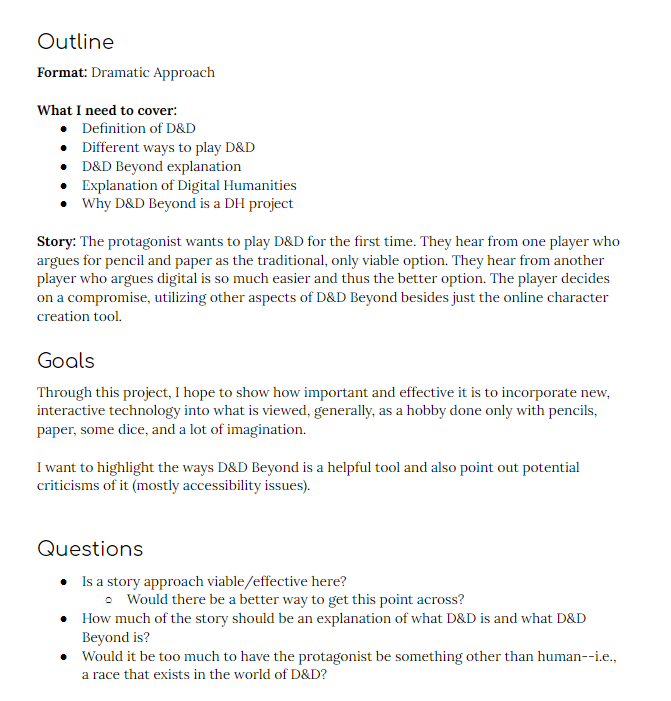
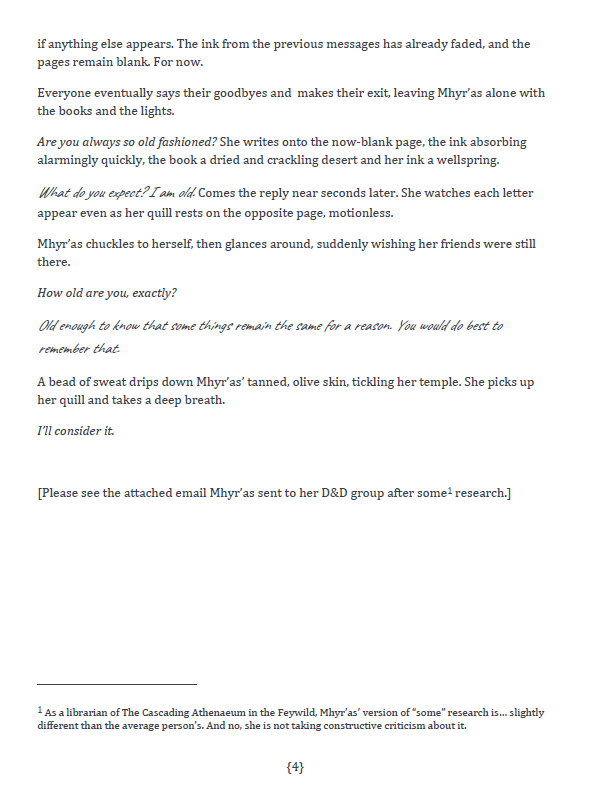

Writing is one of my favorite hobbies, so I was excited to take a traditional report and put a creative writing twist on it. As I said earlier, I’m all for disrupting what’s expected, which is part of why I enjoy Digital Humanities so much. I love that this project allowed us to ask: why are we constantly asking to be delivered information in a report format? Compiling a report is more than just the words on the page of the report, obviously. So, I understand why many professors and classes have assignments where students are given (or choose) a topic, are sent to learn about that topic, digest the information, and then give it back in a specific format. It teaches a bunch of skills (how to seek information properly and efficiently, how to disseminate between true and false information, how to think critically, how to be concise, how to form an argument, etc.). However, what doesn’t make much sense is why most classes never want you to deviate from the traditional format. Why does the report have to use APA citations? Why does it have to be on a word document with a white background, 12 point sans-serif font? Sure, some of those things are for general legibility, but if you can find a creative way to convey the same information, why not take it and spice things up a bit? That was my favorite aspect of this project, and looking back on it, I wish I had done something even more out of the box (different colors, embed the report on a webpage instead of a PDF, landscape orientation, etc.).
Digital Humanities Project Video—New Era, Same Game: The Role of D&D Beyond in Dungeons & Dragons
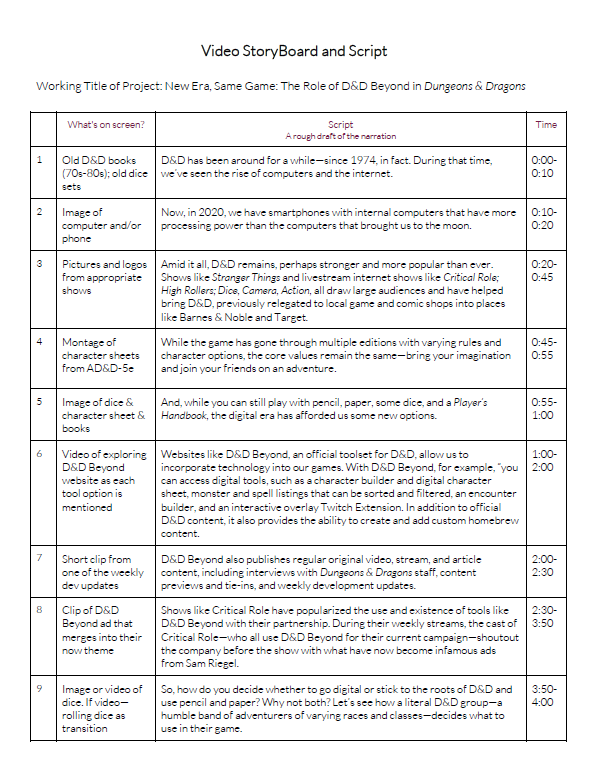

After finishing and revising this project, what I learned was that, as expected, translating from text to video is difficult. The text version of this assignment was fun and out of the box in its own right since I chose the dramatic approach and explained D&D Beyond through the lens of my D&D group’s characters. However, when trying to make this a video, it felt like I needed a sort of introduction to what I was talking about, and I didn’t want to simply read the creative writing piece I did for the previous aspect of the project. So, I did an introduction, brought in some elements from a popular group (Critical Role) that uses D&D Beyond on their weekly livestream, and combined it with reading a small portion of the story. I felt like I had more freedom in the story because I was only handling one element—words. I was able to show words and present them in a different way (for example, including a mock email at the end of the document that was able to explain elements of D&D Beyond that would have felt weird and forced for the characters to talk aloud about). However, working on the video, while fun, was much more difficult. In a way, having more options felt more restraining. I had all these options, but I felt as though I had to make them work to translate what I already had without directly copying it, all while feeling natural, unique, and engrossing. It’s certainly a tall order, and ironically, I think reading the parts of my story at the end of the video ended up being the weakest part, but I’m still happy with it.
Podcast: They’re Watching Us (Group & Individual)
This project was interesting. When we were talking about topics in class, we all selected two or three that we found interesting. People were moved among groups multiple times, and once we settled into groups, I realized we chose those topics because that was what we were going to do a podcast about—the whole thing was a bit chaotic. But, it ended up being fun, and the chaos didn’t stop there (as someone who usually plays chaotic-aligned characters in D&D, I’m here for it).
When we would get together in class, my group would have really natural, interesting, and topical conversations about data privacy and what that means in today’s digital age. When it came time to prepare for the podcast and meet in the library, only two of the four group members showed up (I won’t call anyone out here because that’s petty, but shoutout to that other group member who showed up—I appreciate you). Anyway, when it came time to record the actual podcast in front of the class, it was technically our first run through of it, but I think it came out really well. The conversation was natural, and it felt like a planned piece. In fact, I think it may have suffered if we had done a run through and tried to remember and emulate what we did the first time. In the end, it felt like another way to deliver a written report without just writing a report and reading it aloud (because that’s not really an alternative since you’re still writing the same old boring report with the same old format). We were given a topic, went to find information, and had to find a way to condense what we found and present it in a (hopefully) entertaining way.
The group podcast was nearly 25 minutes long, but through the ~magic~ of editing, I was able to cut it in half to 12 minutes through my first round of revisions. The easiest things to cut were vocal fillers, silences, and just general comments that were not directly on topic (restarting sentences to reword them, for example). However, after receiving some feedback on the first edit, I decided to choose the podcast as the project that could use another revision. Part of my interest in this is because I have the least amount of experience in editing strictly audio, so I wanted a challenge. I also agree with the feedback—it could be even more concise.
For the sake of convenience, I’ve include the original revised podcast and the revised revised podcast here (original first, revised second). For a more in depth look at what it was like to revisit this podcast, check out the portfolio video section.
Pinterest Video
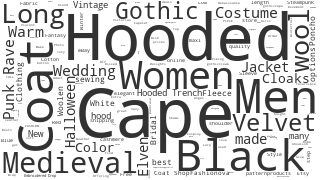
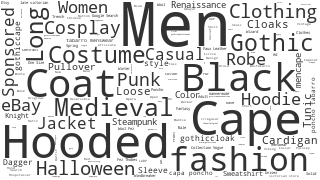
This video was the most difficult to make. With the D&D Beyond video, there was so much I wanted to add, but I felt as though I was able to consolidate the information enough for it to still make sense at the length given. This video, however, felt as though it had so much more going on that I couldn’t possibly fit it all in within the allotted time. However, I also don’t think the solution is just to make a longer video—that feels like a cop out. What my problem was, at the core, is that I felt as though we didn’t do enough research (and couldn’t do enough within the framework of this course) to really make a compelling argument. It was interesting to see what Pinterest said between the profiles I made, but I didn’t feel as though I couldn’t back up any claims about why Pinterest may have showed different photos between the profiles. Just one or two examples did not feel like sufficient evidence.
However, that does not mean there was nothing to be found within the exploration of the topic. There were cases of Pinterest bringing up the same image(s) for the color searched between profiles, which implies Pinterest is just showing the same things regardless of what you make your profile to be. But other, more specific searches were bringing in different, sometimes gendered results. I think I would have liked this project better if there was some way to bring in the findings of the entire class (through a shared document of sorts, perhaps?) or at least in smaller groups.
I also think the focus on what images are retrieved downplays one of the more interesting aspects of the video to me—the behind the scenes profile Pinterest keeps of its users. It goes back to what my group discussed in our podcast: sure, you know corporations (and other groups like the government) are keeping information on you, and most of the time you’re fine with it if/when you get a service in return, but how much is too much? For me, it was a little jarring to see all those fields that Pinterest keeps about me when all I ever entered is some basic demographic info. At the same time, what other service could I use to replace what Pinterest provides? Is it worth switching just because Pinterest collects some information and then uses that to show images it thinks I’ll like? It’s hard to say, but it’s definitely worth the investigation. Looking back on it, I just wish we had more time to collect a larger sample of data from more perspectives to see what else might be influencing Pinterest’s decisions.
Portfolio Video
Making this video came much easier than doing the other videos, and I’m not sure if it’s just because I’ve become used to making them or if it was just what the video entailed that was easier. I decided I wanted to approach this video a bit differently than the ones before by not making or reading from a script. While I noticed a few more vocal fillers, I think the overall quality was less choppy and more natural sounding, which I enjoyed. In that way, the video felt more authentic. I was worried about creating a script and reading from it because this video goes over why I decided to edit the podcast and how I did so, and I felt as though reading from a script would have felt like reading from a report—too typical. It’s not like the D&D Beyond video where a script helped keep me focused due to the sheer amount of information I wanted/needed to cover. Again, as I’ve mentioned before, whenever there’s an opportunity to shake up tradition, I’m here for it.
I decided to revisit the podcast because I had the least amount of experience with Audacity and with making podcasts. Due to the structure of the course, we’ve been able to make multiple videos (and even revise one, if we choose), but we only get one change to work with strictly audio. Whenever you’re working with less material, in this case, nothing on the screen to distract the viewer, every little detail makes a bigger impact. So, I wanted to work on the podcast because I knew it would be a challenge. The easy part of editing the podcast happened when I did the first round of revisions and cut it from 25 to 12 minutes. Cutting out silences, vocal fillers, and distracted side comments are an easy way to edit and cut the time. Truly polishing a piece is much harder because you have to work harder to find all the little parts that can be improved (and you have to be open to acknowledging that it can be improved in the first place). In the end, I took Professor Anderson’s advice and worked to reduce the sound of the distortion noise sound clip we used, and I also tried to even out the audio levels between speakers in my group since some people were closer to the microphone and had louder audio than others. In all, I’m happy with the way the piece turned out, and I think it shows that you don’t always have to cut and reduce to make improvements, but that doesn’t mean making improvements is easy.
Website comments/postings
The following are comments, not including the individual postings for project submissions and/or revisions or comments given during group work sessions when class was held in person.
Tuesday, March 31 Captivating Algorithms
